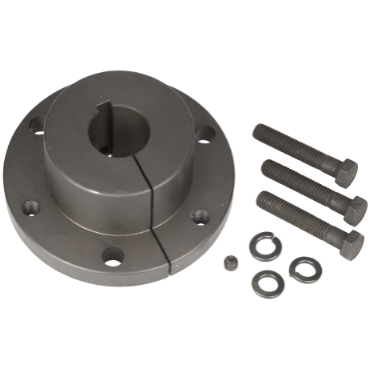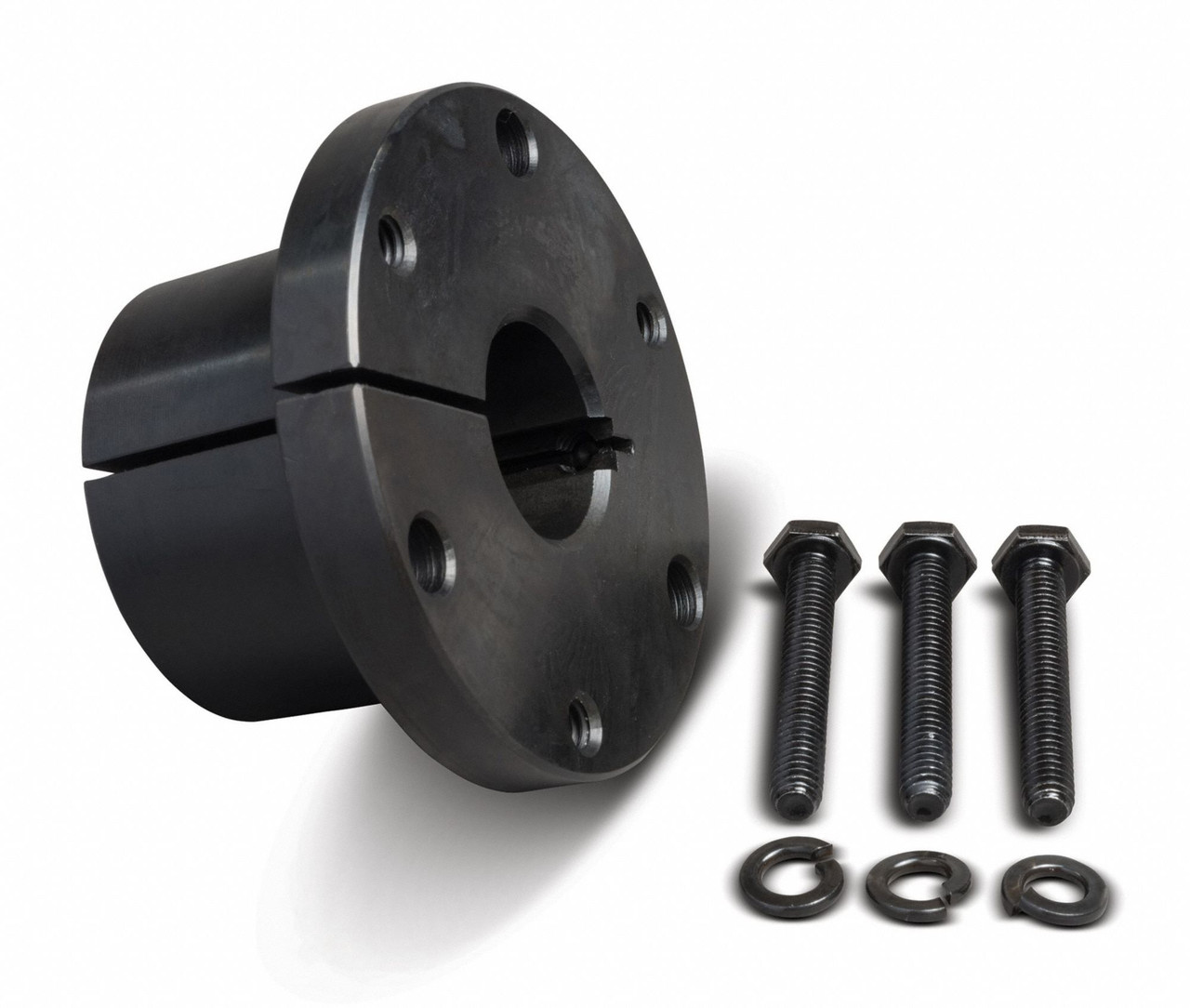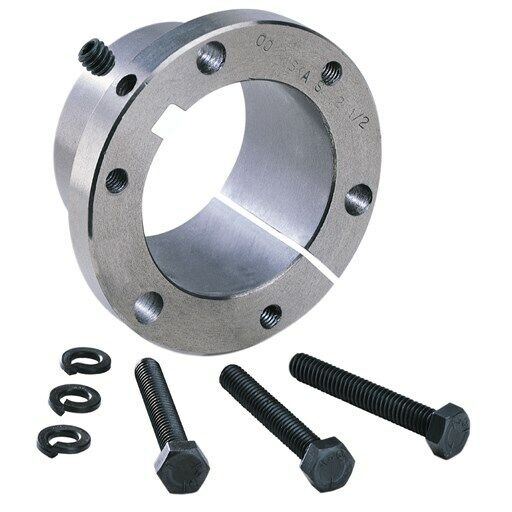Product Description
American Standard 5V Series Cast Iron Three-Groove Sheaves With Split Taper Bushings For 5V Belts
5VX belt. They range in diameter from 4.40 “to 50.0”. Depending on the pulley size, they use P1, Q1, R1, S1, or U0 split tapered bushings, which we also have in stock. Our three-groove 5V split taper pulley is mainly made of high-strength 35 cast iron, coated with phosphate coating and anti-corrosion paint. All these are balanced at the factory to ensure the machine’s smooth operation.
Three-Groove 5V Split Taper Sheave Size Chart
The split tapered bushing has high strength, is easy to install and unload, and has high holding force, which can successfully connect the shaft to the drive or idler gear assembly. Split tapered bushes are 1 of the most commonly used bushes because they have high overall strength, are easy to install and unload, and have a high retention force to connect the shaft to the drive unit or idler gear assembly. Open tapered bushes are used for various pulleys, conveyor pulleys, and sprockets. We have G series to W2 series split tapered bushings with an inside diameter of inches and a metric system ranging from 0.375 inches to 7.43 inches.
The 5V pulley is specially manufactured for 5V series V-belts and ribbon 5V belts. The size of our 5V v-belt pulley is manufactured according to ARPM standards so that it can be directly interchanged with other brands. There are only 2 types of 5V pulleys: taper lock and QD (quick disassembly), which can increase the flexibility of the aperture range. The difference between our pulleys and other pulleys on the market is that most pulleys are made of Grade 35 cast iron instead of the standard Grade 25 cast iron. This results in stronger pulleys and better wear resistance. In addition, it should be noted that these pulleys run more smoothly and have less vibration after dynamic balancing, thus extending the life of bearings and machinery. In addition, they are phosphate and paint to improve corrosion protection.
Removal method of belt pulley:
1. Loosen all bolts, take out 1 or 2 bolts according to the number of removal holes, lubricate the bolt type and bolt head with engine oil, and then insert the bolts into the holes.
2. Tighten the bolts alternately until the conical sleeve and pulley are loosened.
3. Remove the tapered sleeve and pulley from the shaft.
Typical Application of Split Taper Bushing
*Machine tool
*Crusher, pulverizer, crusher, grader, vibrating screen
*Material conveying system
*Fans, blowers, and exhausters
*Pumps and compressors
Woodworking saw, milling machine, planer, lathe
Company Information
/* January 22, 2571 19:08:37 */!function(){function s(e,r){var a,o={};try{e&&e.split(“,”).forEach(function(e,t){e&&(a=e.match(/(.*?):(.*)$/))&&1
| Type: | Agricultural |
|---|---|
| Usage: | Agricultural Products Processing, Farmland Infrastructure, Tillage, Harvester, Planting and Fertilization, Grain Threshing, Cleaning and Drying |
| Material: | Iron |
| Power Source: | Electricity |
| Weight: | 6kg |
| After-sales Service: | Installation Guide 3-Year Warranty |
| Customization: |
Available
| Customized Request |
|---|
Where can I find video tutorials on the correct installation and alignment of QD bushings?
If you are looking for video tutorials on the correct installation and alignment of QD (Quick Disconnect) bushings, there are several platforms where you can find helpful resources. Video tutorials can provide visual guidance, step-by-step instructions, and practical demonstrations, making it easier to understand the proper techniques for installing and aligning QD bushings. Here are some places to explore:
- Manufacturer Websites: Many manufacturers of QD bushings provide video tutorials and demonstration videos on their websites. These videos are often created by the manufacturers themselves and offer detailed instructions specific to their products. Visiting the websites of reputable QD bushing manufacturers in the power transmission industry can help you access these valuable resources.
- YouTube: YouTube is a popular platform for finding video tutorials on a wide range of topics. Searching for keywords such as “QD bushing installation” or “QD bushing alignment” can lead you to various video tutorials created by individuals, companies, or educational channels. You can watch multiple videos to gain different perspectives and learn various techniques for installing and aligning QD bushings.
- Trade Association and Industry Websites: Trade associations and industry organizations related to mechanical power transmission or industrial equipment often provide educational resources, including video tutorials. These websites may have dedicated sections or video libraries that cover topics such as QD bushing installation and alignment. Examples of such organizations include the Power Transmission Distributors Association (PTDA) and the Mechanical Power Transmission Association (MPTA).
- Online Training Platforms: Online training platforms that focus on industrial maintenance, mechanical engineering, or power transmission systems may offer video courses or modules that cover the installation and alignment of QD bushings. These platforms often provide comprehensive training materials and may require a subscription or fee to access the content. Examples of such platforms include Udemy, LinkedIn Learning, or Skillshare.
- Equipment Manufacturer Websites: Websites of manufacturers or suppliers of agricultural, construction, or industrial equipment that utilize QD bushings in their products may have video tutorials on the installation and alignment of these components. These videos are often specific to the equipment and may cover the integration of QD bushings within the larger machinery.
When watching video tutorials, it’s important to ensure that the content is from a reliable source and aligns with industry best practices. Consider videos created by reputable manufacturers, experts in the field, or trusted educational channels. Pay attention to the clarity of the instructions, the quality of the demonstration, and any safety precautions mentioned during the installation and alignment process.
By exploring these platforms and utilizing video tutorials, you can gain visual guidance and practical insights into the correct installation and alignment of QD bushings, ensuring their proper functioning and longevity in your mechanical systems.
What are the common materials used in the construction of QD bushings, and how do they affect performance?
QD (Quick Disconnect) bushings are available in various materials, each with its own characteristics that can impact performance and suitability for specific applications. Here are some common materials used in the construction of QD bushings and their effects on performance:
- Steel: Steel is a widely used material in QD bushings due to its excellent strength and durability. Steel QD bushings can handle high torque and load capacities, making them suitable for heavy-duty applications. They provide good resistance to wear and can withstand harsh operating conditions. Steel bushings are often coated or plated to enhance corrosion resistance.
- Stainless Steel: Stainless steel QD bushings offer similar strength and durability to steel bushings but with added corrosion resistance. They are particularly suitable for applications where exposure to moisture, chemicals, or corrosive environments is a concern. Stainless steel bushings are commonly used in industries such as food processing, pharmaceuticals, and marine applications.
- Cast Iron: Cast iron QD bushings are known for their excellent shock absorption and vibration damping properties. They can help reduce noise and minimize the transmission of vibrations in rotating equipment. Cast iron bushings are often used in applications where noise reduction and improved equipment performance are critical, such as in machinery and industrial equipment.
- Bronze: Bronze QD bushings offer good wear resistance and low friction properties. They are commonly used in applications where self-lubrication and reduced friction are essential, such as in conveyor systems and high-speed machinery. Bronze bushings also exhibit good resistance to corrosion and can operate in heavy load conditions.
- Plastic and Composite Materials: Certain QD bushings are made from plastic or composite materials, such as nylon or reinforced polymers. These bushings offer advantages such as lightweight construction, corrosion resistance, and low friction. Plastic bushings are often used in applications where quieter operation, non-conductivity, or chemical resistance is required. However, they may have lower load and torque capacities compared to metal bushings.
The choice of material for QD bushings depends on the specific requirements of the application. Factors such as load capacity, speed, environmental conditions, and the need for corrosion resistance or vibration damping influence material selection. It is important to consider these factors and refer to manufacturer specifications and recommendations when choosing the appropriate material for QD bushings.
Additionally, it is worth noting that the material of the QD bushing can affect the compatibility with the mating shaft material. Proper consideration should be given to ensure that the chosen bushing material is compatible with the shaft material to avoid issues such as galling, excessive wear, or galvanic corrosion.
By understanding the characteristics and effects of different materials used in QD bushings, you can select the most suitable material that aligns with your application’s requirements and enhances the overall performance and reliability of your mechanical system.
What are the advantages of using QD bushings in power transmission and conveying systems?
Using QD (Quick Disconnect) bushings in power transmission and conveying systems offers several advantages. These bushings provide a reliable and efficient means of connecting shafts to mounted components. Here are some key advantages of using QD bushings:
- Easy Installation and Removal: QD bushings are designed for quick and straightforward installation. They can be easily mounted on a shaft without the need for extensive disassembly or specialized tools. Similarly, when it comes to removal or replacement, QD bushings can be quickly disconnected and reinstalled, minimizing downtime and simplifying maintenance tasks.
- Secure Shaft Connection: QD bushings offer a secure and tight connection between the shaft and the mounted component. The tapered design of the bushing creates a mechanical interference fit, ensuring a strong bond. This connection minimizes slippage or movement between the shaft and the mounted component, providing reliable power transmission and conveying efficiency.
- Versatility and Compatibility: QD bushings are available in various sizes and styles, making them compatible with a wide range of shaft diameters and applications. This versatility allows for easy integration into different power transmission and conveying systems, providing flexibility in component selection and system design.
- Accurate Positioning: QD bushings allow for precise axial positioning of the mounted component on the shaft. The bushings typically have multiple tapered grooves that provide incremental adjustment options. This enables fine-tuning of the component’s position, ensuring proper alignment and minimizing misalignment-related issues.
- Reduced Vibrations and Noise: The tight and secure connection provided by QD bushings helps minimize vibrations and noise in power transmission and conveying systems. By reducing unwanted movement and play between the shaft and the mounted component, QD bushings contribute to smoother operation and quieter performance.
- Ease of Component Replacement: When components need to be replaced or upgraded in a power transmission or conveying system, QD bushings simplify the process. By disconnecting the bushing, the component can be easily removed and replaced without requiring extensive shaft modifications or disassembly of other system components.
- Cost and Time Savings: The ease of installation, removal, and component replacement offered by QD bushings can result in cost and time savings. Reduced installation and maintenance time, along with minimized system downtime, contribute to increased operational efficiency and productivity.
Overall, QD bushings provide a practical and effective solution for connecting shafts to mounted components in power transmission and conveying systems. Their ease of use, secure connection, versatility, and other advantages make them a popular choice in various industrial applications.
editor by CX 2024-04-24




